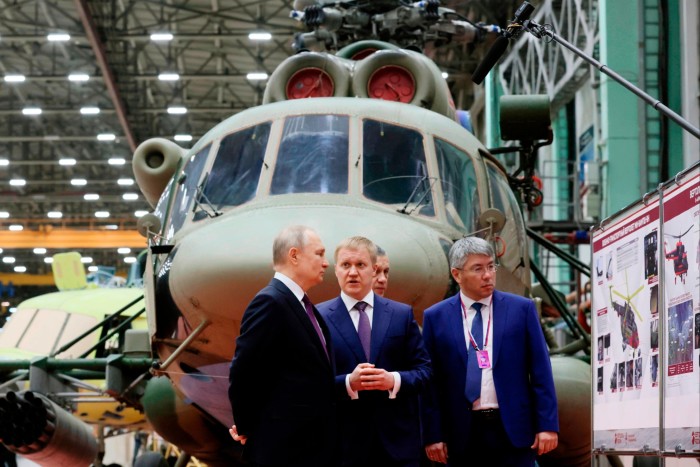Russian “Dragon Tooth” tank traps, minefields and layers of fortifications are just a series of obstacles to Ukraine’s budding counteroffensive. Another formidable enemy turns out to be airborne, including the Russian Ka-52 “Alligator” attack helicopters.
During an early battle near Orikhiv in Zaporozhye Province, a Ukrainian infantry company drove into a minefield and was reportedly under crocodile fire, losing several U.S.-supplied Bradley infantry fighting vehicles and a German Manufactured Leopard 2 tank.
It is unclear how many vehicles were destroyed or later recovered. Kiev also did not say how many Ukrainian soldiers were killed. But images of that battle shared by Russian media and pro-war bloggers are a powerful illustration of the hurdles Ukrainian forces must overcome.
Ukrainian military and Western analysts and officials have long emphasized the role of aviation, including the role of Russian fighter jets and attack helicopters in striking Ukrainian armor, and the lack of front-line air defenses to stop them.
“I saw firsthand how, during our attack, enemy (jet fighter) aircraft immediately opened fire on our advancing troops with laser-guided bombs from a distance,” said Stass, an elite drone surveillance officer. Troop soldiers are helping infantry retake lost ground in the southern part of the country. He said this was not an isolated incident.
Stass said Russia’s use of helicopters to attack armor was a “very powerful technology” that Ukraine could not match, and he implored the West to provide Ukraine with U.S. Apache attack helicopters in addition to F-16 fighter jets.

Last week, Ukrainian President Volodymyr Zelenskyy paid tribute to his forces for continuing to advance into Russian-held territory in defiance of Russia’s “air and artillery superiority”.
Earlier this month, Moscow deployed another 20 helicopters, including Alligator helicopters, to an airfield near Berdyansk, 100 kilometers from Orishiv, which has become the main base for the Rotor operation.
“In the ongoing contest between aerial and countermeasures, Russia is likely to have gained a temporary advantage in southern Ukraine, particularly with attack helicopters using long-range missiles to strike ground targets,” Britain’s defense intelligence service tweeted over the weekend.
Despite its technological superiority, the Russian air force never gained control of Ukraine’s airspace due to Ukraine’s extensive Soviet-era air defense system, which was later backed up by Western systems. Russian fighter jets cross the front lines too far into Ukrainian territory and risk being shot down.
Russian fighter jets and helicopters are now on the front lines to exploit flaws in Ukraine’s air defenses. Kiev operates a different soviet era surface to air missile system, but too few of them to provide full cover, so it relies somewhat on very short range shoulder fired missiles (Manpads) which require the operator to look before firing to the target.
“At night, man-portable anti-aircraft missiles are not very effective,” said a Ukrainian Air Force pilot. “We need systems with detection and guidance – radar or electro-optical systems,” the pilot added.
Russian helicopters armed with anti-tank missiles “are always a much greater threat to Ukrainian forces during a counteroffensive than during an offensive when Ukraine is defending against a Russian attack,” said Justin Bronk, a senior fellow at the Royal United Services Institute think tank in London.
“They can hover, spot targets and launch anti-tank guided missiles from beyond the range of shoulder-mounted man-portable anti-aircraft missiles or anti-aircraft fire,” Bronk said.
That has left the Ukrainian military constantly weighing the risks of deploying its rare surface-to-air missile systems closer to the front lines against the cost of exposing their armored vehicles to Russian fire.
Russia’s missile attacks on several Ukrainian cities have intensified since early May, and the Ukrainian armed forces have had to retain their surface-to-air missile systems to protect civilians rather than move them to the front lines. Losses in the opening battle of the Ukrainian army’s counteroffensive have sparked a rush by Western allies to supply Kiev with additional air defense systems and ammunition.
Britain said last week that it joined the United States, Denmark and the Netherlands in buying “hundreds of short and medium-range air defense systems”, mostly Soviet-era, to be delivered in the coming weeks.
On Monday, French President Emmanuel Macron announced that the earlier promised French-Italian SAMP-T system was now “operational” in Ukraine.
“The most important issue for Ukraine is that we need to have two air defense missions at the same time — protecting major urban areas and industry. . . , because we lack land base (air defense). The systems themselves could be targeted by Russian Lancet kamikaze drones, Bieliskov warned.
The Ka-52 helicopter is not foolproof. When the Russian Ministry of Defense showed a video of a Panther tank hit in the open, Western analysts determined that the destroyed target was a crop sprayer, embarrassing Moscow.
Alligators are also extremely vulnerable to surface-to-air missiles at range. According to Oryx, which documents equipment losses during the war, Russia has lost at least 35 since last February. Ukrainian air force spokesman Colonel Yuri Ignat claimed four planes were shot down last week.
Ignat played down the threat of Russian attack helicopters during the counteroffensive.
“The Ka-52 is definitely not a helicopter for establishing air superiority,” Ignat said, nor does it provide “decisive firepower on the battlefield.”
The greater aviation threat to the Ukrainian military comes from Russian fighter jets, which have more powerful radars and long-range missiles than Ukraine’s older Soviet-made aircraft, Ignat said. The vulnerability of the Ukrainian military highlights the need for Western-built jets such as the F-16, he said.
Frontline drone operator Stass said Ukraine needed F-16s and U.S. helicopters to protect ground forces.
“Offensive operations require air cover and the most important thing right now is to attack because if we don’t win this war quickly, if we don’t take back all of our territory, it’s going to drag on,” he said.
Additional reporting by John Paul Rathbone in London




